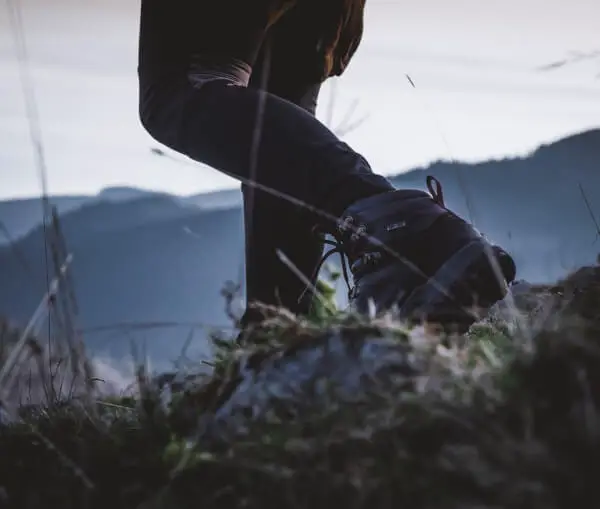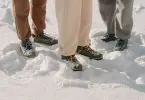Hiking can be a great past time and a nice way to spend the day exploring the nature around you. Although most people view hiking as a fun activity, it should be one that is taken seriously. It is important to prepare yourself for a hike, whether you’re going for an hour or a full day.
Hiking often involves walking for miles in the mountains, forests, and open terrains. These elements can present dangers and threats to your safety if you are not prepared for them. This Hiking Safety Guide is meant to prepare hikers of all skill levels for the unexpected and often times unseen dangers of hiking.
Must read: Tips on Training for Backpacking: Preparing Your Body for the Great Outdoors
In order to have a fun and successful hike, it is important to follow these steps to prepare yourself for unforeseen situations. This guide includes tips on what to do as you are preparing to go on your hike, during your hike, and in the case that an unsafe situation does arise.
It will go over common mistakes that everyone from beginning to advanced hikers are susceptible to. By familiarizing yourself with these easy to follow safety guides and tips, you can make sure that your next hike is a fun and safe one!
Preparing for Safety: What To Do Before you Leave For a Hike
Several official hiking organizations such as the American Hiking Society, the Backpacker Magazine, and Washington Trails Association along with several others, promote the list of “The Ten Essentials.” These are things that you may not think you would need for a simple day hike or an hour-long excursion but these will come in handy for all kinds of emergencies and dangerous situations that may arise.
Here’s the list that most hiking experts agree on, in no particular order:
Navigation: Map and compass/GPS
Having a map and compass, or a more modern day GPS system with you as you go on your hike can be very helpful in telling you your location, and how far you’ve gone. It’s a good idea to put these items in a waterproof container or bag, so that water damage doesn’t occur from rain or an accidental drop in a stream. Do check our article review of the best GPS watches to help you choose your gear.
It’s recommended that you carry a map and compass even if you bring along a GPS because technology can be unreliable, things can break and batteries can die.
Sun Protection: Sunscreen and Sunglasses
Especially in cooler or cloudy weather, hikers often don’t think about bringing sun protection along with them. But as you increase in altitude, so does your proximity to the sun’s unforgiving rays.
If you’re hiking in winter conditions, sunglasses can help prevent snow blindness and can also improve visibility. You can add a hat to this list in addition to sunscreen to add additional protection to your head and face. For the top waterproof sunscreen to protect your skin, check this out for more information.
Extra clothing: Rain Gear and Layers
Even if the forecast calls for blue skies all day, experienced hikers know how the weatherman’s words are not to be taken too seriously once you’re on the trail. Conditions in mountainous terrain are known to change quickly and without warning. Our useful tips on backpacking in the rain will help you thrive in any downpour.
You’ll be thankful that you brought along a rain coat when it starts pouring cats and dogs. Wearing layers gives you the ability to take them off when you start to work up a sweat, and know that they’re there in case the temperature drops.
Light: Headlamps and Flashlight
Get yourself a headlamp, flashlight or both in case you get lost and find yourself on the trails after sundown. Something with an LED bulb can help ensure a longer battery life.
Safety Items: Fire and a Whistle
It’s basic survival knowledge that having the ability to create fire during an emergency situation on the trails can be the difference between life or death. It’s always a good idea to bring a Butane lighter with you, and matches sealed in a waterproof container. Having access to fire can save you from hypothermia and serve as a distress signal to make you more visible to rescuers.
A whistle is also an important item to have. Blowing three loud, short blasts signals distress and can make it easier for other hikers and people on the trail to hear you.
Hydration: Extra Water and a Purifier
Staying hydrated is important to any physical activity, especially hiking. Water is essential to life, and if you are caught out in the elements without enough of it, your chances of survival are low. Bring more water than you think you’ll need, and a portable water purifier to create your own drinking water if you get stranded.
Nutrition: Extra Food
Bringing along snacks will help you keep your energy level up. Snacks like protein bars, peanuts, and trail mixes have a great combination of protein, carbohydrates and nutrients to keep you fueled all day.
You should also bring more food than you think you need, in case you decide to stay out on the trail longer or you get lost.
First Aid: First Aid Supply Kits and Knowledge
It’s as important to bring a proper first aid kit on a hike, as it is to bring with you proper first aid knowledge. You don’t have to get certified but that is always a good option.
Just reading up on basic first aid procedures, how to use the things in your kit, and what to do in certain situations can help save someone’s life or your own.
Repair Kit: Knife and Multi-Purpose tools
A good knife, along with a multi-purpose tool that includes scissors, a file, and a screwdriver can help you in case you need to cut cloth into bandages, remove splinters, cut yourself free from your backpack or aid in self-defense. For the best hiking knife that won’t let you down, check out our earlier piece for reference.
Emergency Shelter: Tarp and Space Blanket
The minimum that you should bring with you on any hiking trip is a waterproof tarp, and a space blanket. Both things are light and can easily fit into your hiking backpack.
They are very useful if you get lost on the trail and have to spend the night in the elements. Temperatures can drop dramatically in high altitudes when the sun goes down and you’re going to need to keep yourself warm and dry.
Research: Know the Location Where You’re Hiking
Before you leave for your hike, take a couple hours to look up the park or trail where you plan on going. Every national park has its own website, and is a great resource for finding information on the terrain, flora and fauna and safety tips particular to that park and trails. Some things to consider looking up before you leave:
Terrain
Are you going to be dealing with mountains or the desert? Are there streams that you’ll need to cross, or rocks that you’ll need to scale?
Knowing what kind of terrain you’re going to have to deal with can help you to know what kind of gear you need to bring.
Wildlife
What kinds of animals are native to the area you’re hiking in? Will they’ll be bears that you need to watch out for? Poisonous insects or snakes? Having a good idea of what animals live on the trail will make sure that you don’t encounter surprises and you’re prepared if you run into any wildlife.
Flora
Are there poisonous plants on the trail that you should be aware of? Are there certain things you should avoid touching or eating?
Knowing the local flora on your trail and what it looks like, will help you to avoid walking into any patches of poison ivy or eating any berries that you could harm you.
Talk to Family/Friends About Your Hiking Plans
It’s important to leave a detailed plan of your hike with a reliable person that you trust. Include in the plan what time you’re leaving, when they can expect you to be back and at what time they should start to worry if they haven’t heard from you.
Also, make sure you tell them what location you’re planning on hiking, the trails and the phone number of the park or rangers for them to call if you don’t return.
Check the Forecast and Plan for the Worst
It’s important to check the forecast for the location that you’re going to go hiking a few days before you plan to leave, and the day you leave. If the conditions are forecasted to be harsh, you should reschedule your hike. Even the most experienced hiker can face difficulties when the weather conditions turn nasty.
If the conditions are forecasted to be favorable, plan for the worse and make sure you bring all the necessary gear for every possible situation. The weather is indifferent to you and your hike and nature isn’t compassionate to your needs. Respect the weather, and be prepared.
How to Stay Safe While You’re on the Hike
Leave Sooner Rather Than Later
Start your hike early in the morning so that you have plenty of time to complete it. Make sure you know how many miles your hike is going to be, and approximately how long it will take to finish.
It’s a good idea to factor in your pace and hiking expertise level when estimating the length of your hike. Leaving early in the morning will ensure that you make it back safely before nightfall.
Use the Buddy System: Hike with a Friend
Unless you’re taking a stroll in a nearby, well-traveled trail, never hike alone. It can be easy to get lost on long, winding trails that cut through thick forest. It can also be harder to find your way back to the trail if there is no one around.
As a rule of thumb, two heads are better than one. It’s smart to always have someone else there with you in case of emergencies and if you get lost. You’re less likely to panic and you have someone to assist you with first aid or seek help if you’re too injured.
If you’re hiking in a group, make sure you stay together as a group during the entire hike. It’s important to leave no hiker behind, and make sure every hiker you came with is accountable for.
It’s also smart to split up the food and water you have among the hikers in your group. If one person has all the food and water and they get separated from the group, things can get difficult quickly.
Stay on the Established Trail
There is a trail for a reason. Not only is hiking on the designated trail safer and more reliable, it is also better for the environment around you.
Forging your own trails through the wilderness is dangerous for you and the environment, as it can cause erosion and disrupt the natural habitat of animals living in the surrounding areas.
Use Common Sense
Don’t get over confident even if you’re an experienced hiker or have hiked a trail a million times. Conditions change and overconfidence can be your downfall. Exercising common sense on the trails can help to keep you and those around you safe. Stay on the path, never approach a wild animal, pick up trash and be observant of your surroundings.
What to Do If You Get Lost
Try to Find Your Way Back
If you realize that you’re not on the trail anymore, or are on a wrong trail, the first thing you should do is backtrack. Follow your footsteps by using markers such as unique trees that you remember passing, and shoe imprints in the leaves or dirt.
If you backtrack and you can’t find your way back to the trail, stay where you are, especially if it’s getting dark. It’s important to maintain the same location once you’ve decided that you’re lost. You have a better chance of being found by rescue workers or other hikers that way.
Make Shelter
It’s important to keep yourself dry and warm once you’ve veered off the trail. By following the ten essentials packing list mentioned above, you should have a tarp and a space blanket in your knap sack.
You can use the tarp and the land around you (trees, leaves, rocks) to form a shelter to keep the rain or snow off you. The more you can keep dry and warm, the higher your chances are of survival.
Make Sure You Can Be Seen and Heard
For rescue workers and other hikers to find you, they need to be able to see or hear you. It’s best to always wear bright colors while hiking, such as neon yellows and oranges.
Never dress in camouflage, as that can pose a danger from nearby hunters and make it harder for you to be seen.
Use your whistle to blow three sharp blasts that signals a distress call. If you think somebody is nearby, make constant and loud noise so that they can find their way to you.
Stay Safe on the Trail
By following these tips on hiking safety, your next hike can be an enjoyable and safe experience. Whether you’re an expert hiker or a beginner, it’s important to keep these things in mind when thinking about your safety on the trail. Not only can they help to prevent a dangerous situation from happening, but they can save your life in case one does.
Featured Image Source: https://unsplash.com/photos/hNRbTiXlhzw








